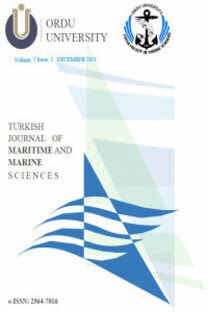The effects of pollution on the distribution of phytoplankton in the surface water of the Golden Horn
Haliç yüzey suyunda kirlenmenin fitoplankton dağılımına olan etkileri
___
- Arağa, Y, (1965). Ecological studies of photosynthesis and matter production of phytoplankton. J. Bot. Mar. Tokyo 78:280-288.
- Guillard, R.R.L. (1978). Counting slides. In: Phytoplankton manual, Sournia, A., (ed.). UNESCO, p 182-189.
- Güçlüer, Ş. and Doğusal, M. (1976). Haliç'te fiziksel oşinografik durumun incelenmesi. İstanbul Haliç Sorunları ve Çözüm Yolları Ulusal Sempozyumu. 11-13 Şubat 1976, s.61-74, Boğaziçi Üniversitesi, İstanbul.
- Gerhard, D. (1974). Marines phytoplankton eine Auswahl der Helgolander planktonalgen (Diatomeen, Peridineen). Georg Thieme Verlag Stuttgart.
- Lederman, T.C. (1983). Primary Production. In: Experimental Biology at Sea. Macdonald, A.G. aiıd Priede, I.C. (eds), 279-310.
- Priddle, J. and Fryxell, G. (1985). Handbook of common plankton diatoms of the Southern Ocean: Centrales except the genus Thalassiosira. Printed in Great Britain at the University Press, Cambridge.
- Rehakova, Z. (1974). Marine diatoms in helvetion sediments of the Central Paratethys Thira Symposium on recent and marine diatoms. September, 9-13, Qk 569 DS 4SIM.
- Ricard, M.and Dorst, J. (1987). Atlas du phytoplankton marin diatomophycees. Membre de I'lnstitut. Vol.II: Editions du Centre National de la Recherche Scientifique Paris.
- Throndsen, J.(1978). Phytoplankton manual. In: Preservation and storage., Sournia, A., (ed.). UNESCO, 69-74.
- Tregouboff, G. and Rose, M. (1957). Manuel de planktonologie Mediterraneenne Tome II. Illustrations. Centre National de la Recherche Scientifique, Paris.
- Uysal, Z. (1987). "Fate and Distribution of Plankton Around the Bosphorus, The Golden Horn, North-eastern Marmara and the Bay of İzmit". Yüksek Lisans Tezi The Middle East Technical University. Institute of Marine Sciences. Erdemli, İçel, Turkey.
- Zar, J.H. (1984). Bioistatistical analysis. Second edition, Prentice-Hall, Inc., Englewood Cliffs, New Jersey.
- ISSN: 1300-7122
- Yayın Aralığı: 1
- Başlangıç: 2018
- Yayıncı: -
Ostracoda (Crustacea) fauna of the Black Sea Coasts of Istanbul
A study on the fishes of Bozcaada Island (North Aegean Sea)
Structural features of the Tuzla region, Istanbul
Check-list of the brachyuran crabs of the Turkish straits system
Kasım Cemal GÜVEN, Kartal ÇETİNTÜRK, Mutlu KÜÇÜK, Mustafa ALPASLAN, A. Adem TEKİNAY
